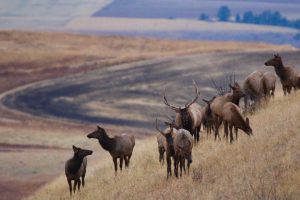An interesting article in the Mountain Journal showcases some stunning photos by Holly Pippel, elegant commentary by Todd Wilkinson and a tip of the hat to Gallatin Valley Land Trust in discussing the impact of Bozeman’s population boom on local wildlife.
Wilkinson writes: Montana has more wild, free-ranging elk than at any point going back at least 140 years. The irony is that northern offshoots of the famous Gallatin elk population which spill out of the Gallatins into the Gallatin Valley at certain times of the year could become small remnants or worse, disappear, as development pushes out inexorably from Bozeman. Will elk that come out of the northern Gallatins soon be unable to reach Ted Turner’s Flying D Ranch west of US Highway 191?
Is Gallatin Valley destined to have only scattered, dwindling pockets of half-wild, half-tame elk that have lost their instinct to migrate, roaming the suburbs and golf course fairways like white-tailed deer?
The article contains a Q&A with Pippel in which she discusses her observations and photography. One photo caption in the article reads: More humans building dream homes and ranchettes can become a nightmare for stressed out wildlife. Condos, often accompanied by traffic, road infrastructure, barking dogs and a maze of other obstacles, are not better for elk than cows or cropland. The Gallatin Valley Land Trust has done a good job taking advantage of opportunities from willing sellers when they arise to attach conservation easements to ag lands. But the group’s ability to save crucial corridors is being outpaced by subdivision.
The photo caption goes on to read: And nowhere are any other Bozeman conservation groups rigorously scrutinizing county decision-making. With more money, the Land Trust could do a lot more by incentivizing conservation choices for property owners. (Ed. Comment: That is not a knock on GVLT. And with significant additional funding every MALT member “could do a lot more.”)

